Environmental Strategies for Resource Conservation and Recovery Report
VerifiedAdded on 2020/04/29
|10
|2750
|99
Report
AI Summary
This report provides an analysis of strategies for resource conservation and recovery, focusing on IBM's environmental, social, and governance (ESG) factors as detailed in their sustainability report. It examines IBM's commitment to environmental leadership through targets for climate protection, conservation, and pollution prevention, highlighting their approach to addressing environmental issues. The report also explores areas for improvement in pollution prevention strategies, emphasizing the role of biodegradable plastics and the Life Cycle Assessment (LCA) framework. Furthermore, it discusses the application of eco-innovation tools, such as LCA, to assess sustainability implications and drive improvements within product systems, including examples from companies like SC Johnson and ACCIONA. The report emphasizes the importance of LCA in identifying environmental impacts and promoting collaboration for sustainable practices across various industries.
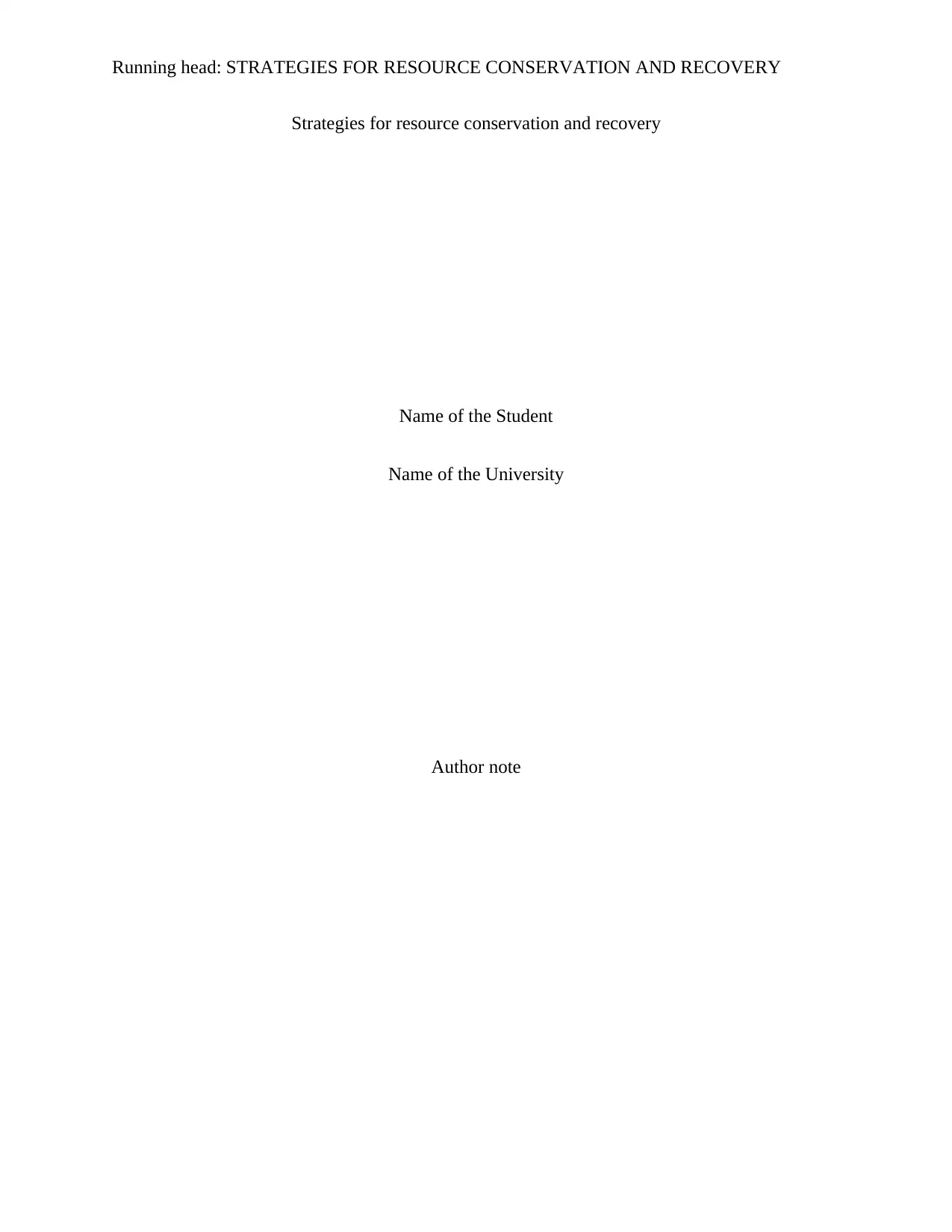
Running head: STRATEGIES FOR RESOURCE CONSERVATION AND RECOVERY
Strategies for resource conservation and recovery
Name of the Student
Name of the University
Author note
Strategies for resource conservation and recovery
Name of the Student
Name of the University
Author note
Paraphrase This Document
Need a fresh take? Get an instant paraphrase of this document with our AI Paraphraser
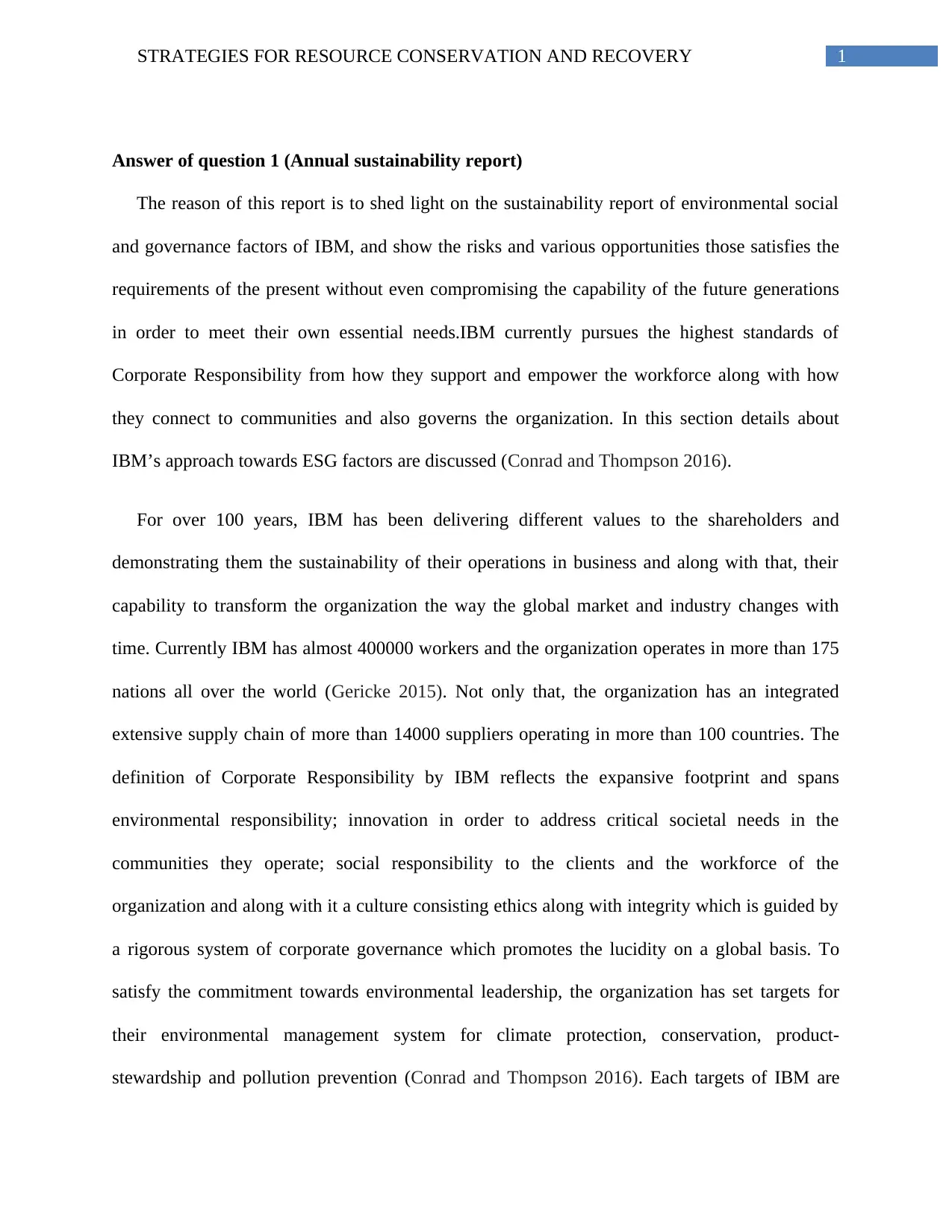
1STRATEGIES FOR RESOURCE CONSERVATION AND RECOVERY
Answer of question 1 (Annual sustainability report)
The reason of this report is to shed light on the sustainability report of environmental social
and governance factors of IBM, and show the risks and various opportunities those satisfies the
requirements of the present without even compromising the capability of the future generations
in order to meet their own essential needs.IBM currently pursues the highest standards of
Corporate Responsibility from how they support and empower the workforce along with how
they connect to communities and also governs the organization. In this section details about
IBM’s approach towards ESG factors are discussed (Conrad and Thompson 2016).
For over 100 years, IBM has been delivering different values to the shareholders and
demonstrating them the sustainability of their operations in business and along with that, their
capability to transform the organization the way the global market and industry changes with
time. Currently IBM has almost 400000 workers and the organization operates in more than 175
nations all over the world (Gericke 2015). Not only that, the organization has an integrated
extensive supply chain of more than 14000 suppliers operating in more than 100 countries. The
definition of Corporate Responsibility by IBM reflects the expansive footprint and spans
environmental responsibility; innovation in order to address critical societal needs in the
communities they operate; social responsibility to the clients and the workforce of the
organization and along with it a culture consisting ethics along with integrity which is guided by
a rigorous system of corporate governance which promotes the lucidity on a global basis. To
satisfy the commitment towards environmental leadership, the organization has set targets for
their environmental management system for climate protection, conservation, product-
stewardship and pollution prevention (Conrad and Thompson 2016). Each targets of IBM are
Answer of question 1 (Annual sustainability report)
The reason of this report is to shed light on the sustainability report of environmental social
and governance factors of IBM, and show the risks and various opportunities those satisfies the
requirements of the present without even compromising the capability of the future generations
in order to meet their own essential needs.IBM currently pursues the highest standards of
Corporate Responsibility from how they support and empower the workforce along with how
they connect to communities and also governs the organization. In this section details about
IBM’s approach towards ESG factors are discussed (Conrad and Thompson 2016).
For over 100 years, IBM has been delivering different values to the shareholders and
demonstrating them the sustainability of their operations in business and along with that, their
capability to transform the organization the way the global market and industry changes with
time. Currently IBM has almost 400000 workers and the organization operates in more than 175
nations all over the world (Gericke 2015). Not only that, the organization has an integrated
extensive supply chain of more than 14000 suppliers operating in more than 100 countries. The
definition of Corporate Responsibility by IBM reflects the expansive footprint and spans
environmental responsibility; innovation in order to address critical societal needs in the
communities they operate; social responsibility to the clients and the workforce of the
organization and along with it a culture consisting ethics along with integrity which is guided by
a rigorous system of corporate governance which promotes the lucidity on a global basis. To
satisfy the commitment towards environmental leadership, the organization has set targets for
their environmental management system for climate protection, conservation, product-
stewardship and pollution prevention (Conrad and Thompson 2016). Each targets of IBM are
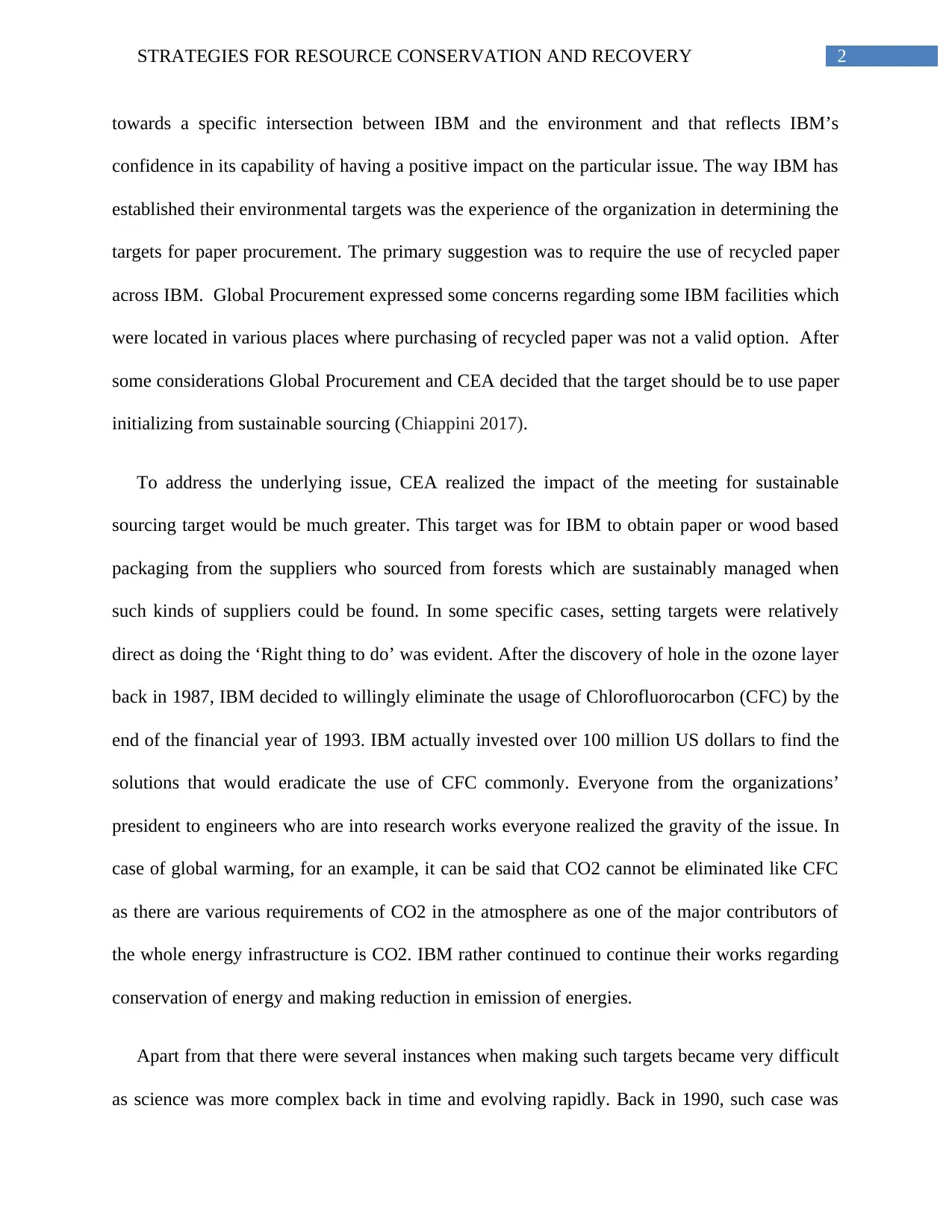
2STRATEGIES FOR RESOURCE CONSERVATION AND RECOVERY
towards a specific intersection between IBM and the environment and that reflects IBM’s
confidence in its capability of having a positive impact on the particular issue. The way IBM has
established their environmental targets was the experience of the organization in determining the
targets for paper procurement. The primary suggestion was to require the use of recycled paper
across IBM. Global Procurement expressed some concerns regarding some IBM facilities which
were located in various places where purchasing of recycled paper was not a valid option. After
some considerations Global Procurement and CEA decided that the target should be to use paper
initializing from sustainable sourcing (Chiappini 2017).
To address the underlying issue, CEA realized the impact of the meeting for sustainable
sourcing target would be much greater. This target was for IBM to obtain paper or wood based
packaging from the suppliers who sourced from forests which are sustainably managed when
such kinds of suppliers could be found. In some specific cases, setting targets were relatively
direct as doing the ‘Right thing to do’ was evident. After the discovery of hole in the ozone layer
back in 1987, IBM decided to willingly eliminate the usage of Chlorofluorocarbon (CFC) by the
end of the financial year of 1993. IBM actually invested over 100 million US dollars to find the
solutions that would eradicate the use of CFC commonly. Everyone from the organizations’
president to engineers who are into research works everyone realized the gravity of the issue. In
case of global warming, for an example, it can be said that CO2 cannot be eliminated like CFC
as there are various requirements of CO2 in the atmosphere as one of the major contributors of
the whole energy infrastructure is CO2. IBM rather continued to continue their works regarding
conservation of energy and making reduction in emission of energies.
Apart from that there were several instances when making such targets became very difficult
as science was more complex back in time and evolving rapidly. Back in 1990, such case was
towards a specific intersection between IBM and the environment and that reflects IBM’s
confidence in its capability of having a positive impact on the particular issue. The way IBM has
established their environmental targets was the experience of the organization in determining the
targets for paper procurement. The primary suggestion was to require the use of recycled paper
across IBM. Global Procurement expressed some concerns regarding some IBM facilities which
were located in various places where purchasing of recycled paper was not a valid option. After
some considerations Global Procurement and CEA decided that the target should be to use paper
initializing from sustainable sourcing (Chiappini 2017).
To address the underlying issue, CEA realized the impact of the meeting for sustainable
sourcing target would be much greater. This target was for IBM to obtain paper or wood based
packaging from the suppliers who sourced from forests which are sustainably managed when
such kinds of suppliers could be found. In some specific cases, setting targets were relatively
direct as doing the ‘Right thing to do’ was evident. After the discovery of hole in the ozone layer
back in 1987, IBM decided to willingly eliminate the usage of Chlorofluorocarbon (CFC) by the
end of the financial year of 1993. IBM actually invested over 100 million US dollars to find the
solutions that would eradicate the use of CFC commonly. Everyone from the organizations’
president to engineers who are into research works everyone realized the gravity of the issue. In
case of global warming, for an example, it can be said that CO2 cannot be eliminated like CFC
as there are various requirements of CO2 in the atmosphere as one of the major contributors of
the whole energy infrastructure is CO2. IBM rather continued to continue their works regarding
conservation of energy and making reduction in emission of energies.
Apart from that there were several instances when making such targets became very difficult
as science was more complex back in time and evolving rapidly. Back in 1990, such case was
⊘ This is a preview!⊘
Do you want full access?
Subscribe today to unlock all pages.

Trusted by 1+ million students worldwide
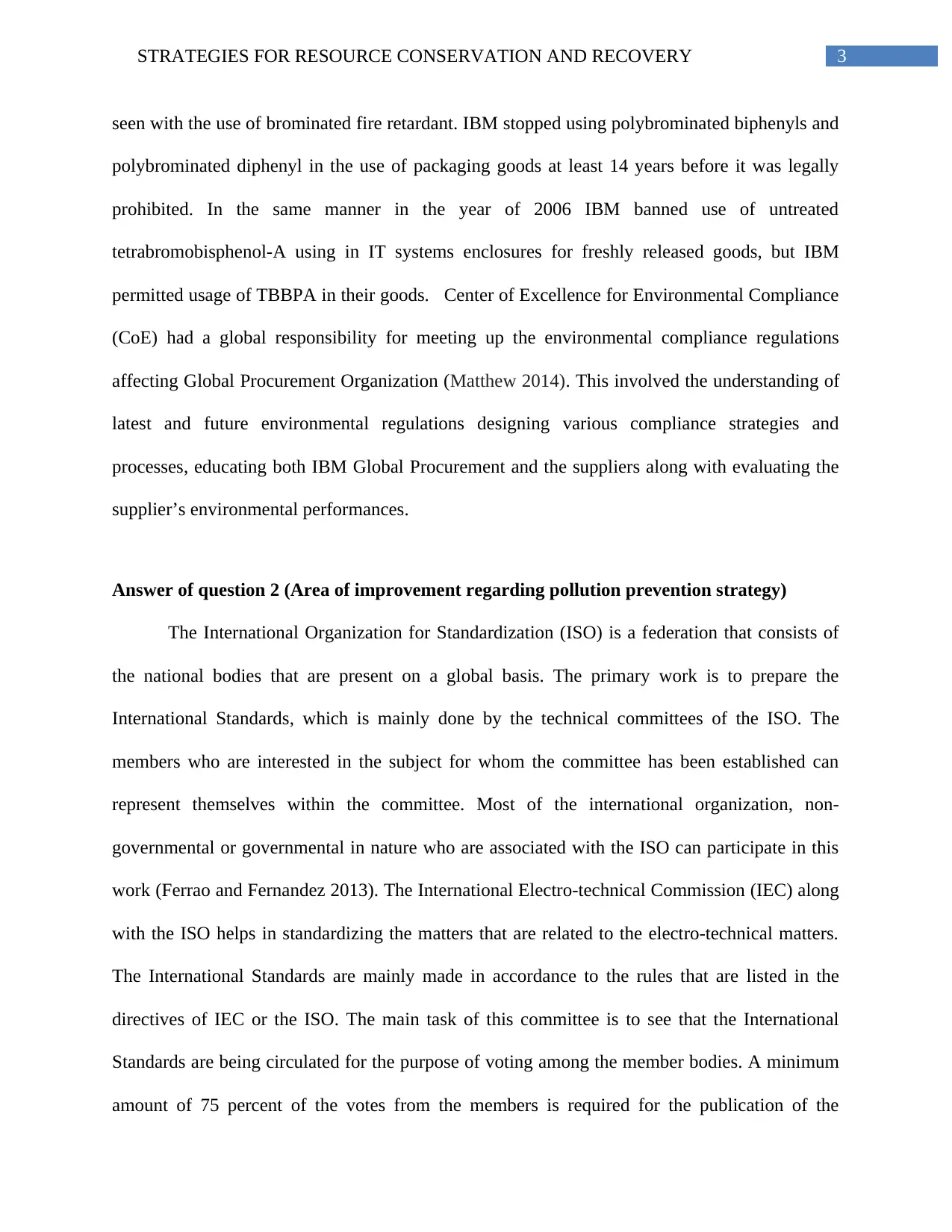
3STRATEGIES FOR RESOURCE CONSERVATION AND RECOVERY
seen with the use of brominated fire retardant. IBM stopped using polybrominated biphenyls and
polybrominated diphenyl in the use of packaging goods at least 14 years before it was legally
prohibited. In the same manner in the year of 2006 IBM banned use of untreated
tetrabromobisphenol-A using in IT systems enclosures for freshly released goods, but IBM
permitted usage of TBBPA in their goods. Center of Excellence for Environmental Compliance
(CoE) had a global responsibility for meeting up the environmental compliance regulations
affecting Global Procurement Organization (Matthew 2014). This involved the understanding of
latest and future environmental regulations designing various compliance strategies and
processes, educating both IBM Global Procurement and the suppliers along with evaluating the
supplier’s environmental performances.
Answer of question 2 (Area of improvement regarding pollution prevention strategy)
The International Organization for Standardization (ISO) is a federation that consists of
the national bodies that are present on a global basis. The primary work is to prepare the
International Standards, which is mainly done by the technical committees of the ISO. The
members who are interested in the subject for whom the committee has been established can
represent themselves within the committee. Most of the international organization, non-
governmental or governmental in nature who are associated with the ISO can participate in this
work (Ferrao and Fernandez 2013). The International Electro-technical Commission (IEC) along
with the ISO helps in standardizing the matters that are related to the electro-technical matters.
The International Standards are mainly made in accordance to the rules that are listed in the
directives of IEC or the ISO. The main task of this committee is to see that the International
Standards are being circulated for the purpose of voting among the member bodies. A minimum
amount of 75 percent of the votes from the members is required for the publication of the
seen with the use of brominated fire retardant. IBM stopped using polybrominated biphenyls and
polybrominated diphenyl in the use of packaging goods at least 14 years before it was legally
prohibited. In the same manner in the year of 2006 IBM banned use of untreated
tetrabromobisphenol-A using in IT systems enclosures for freshly released goods, but IBM
permitted usage of TBBPA in their goods. Center of Excellence for Environmental Compliance
(CoE) had a global responsibility for meeting up the environmental compliance regulations
affecting Global Procurement Organization (Matthew 2014). This involved the understanding of
latest and future environmental regulations designing various compliance strategies and
processes, educating both IBM Global Procurement and the suppliers along with evaluating the
supplier’s environmental performances.
Answer of question 2 (Area of improvement regarding pollution prevention strategy)
The International Organization for Standardization (ISO) is a federation that consists of
the national bodies that are present on a global basis. The primary work is to prepare the
International Standards, which is mainly done by the technical committees of the ISO. The
members who are interested in the subject for whom the committee has been established can
represent themselves within the committee. Most of the international organization, non-
governmental or governmental in nature who are associated with the ISO can participate in this
work (Ferrao and Fernandez 2013). The International Electro-technical Commission (IEC) along
with the ISO helps in standardizing the matters that are related to the electro-technical matters.
The International Standards are mainly made in accordance to the rules that are listed in the
directives of IEC or the ISO. The main task of this committee is to see that the International
Standards are being circulated for the purpose of voting among the member bodies. A minimum
amount of 75 percent of the votes from the members is required for the publication of the
Paraphrase This Document
Need a fresh take? Get an instant paraphrase of this document with our AI Paraphraser
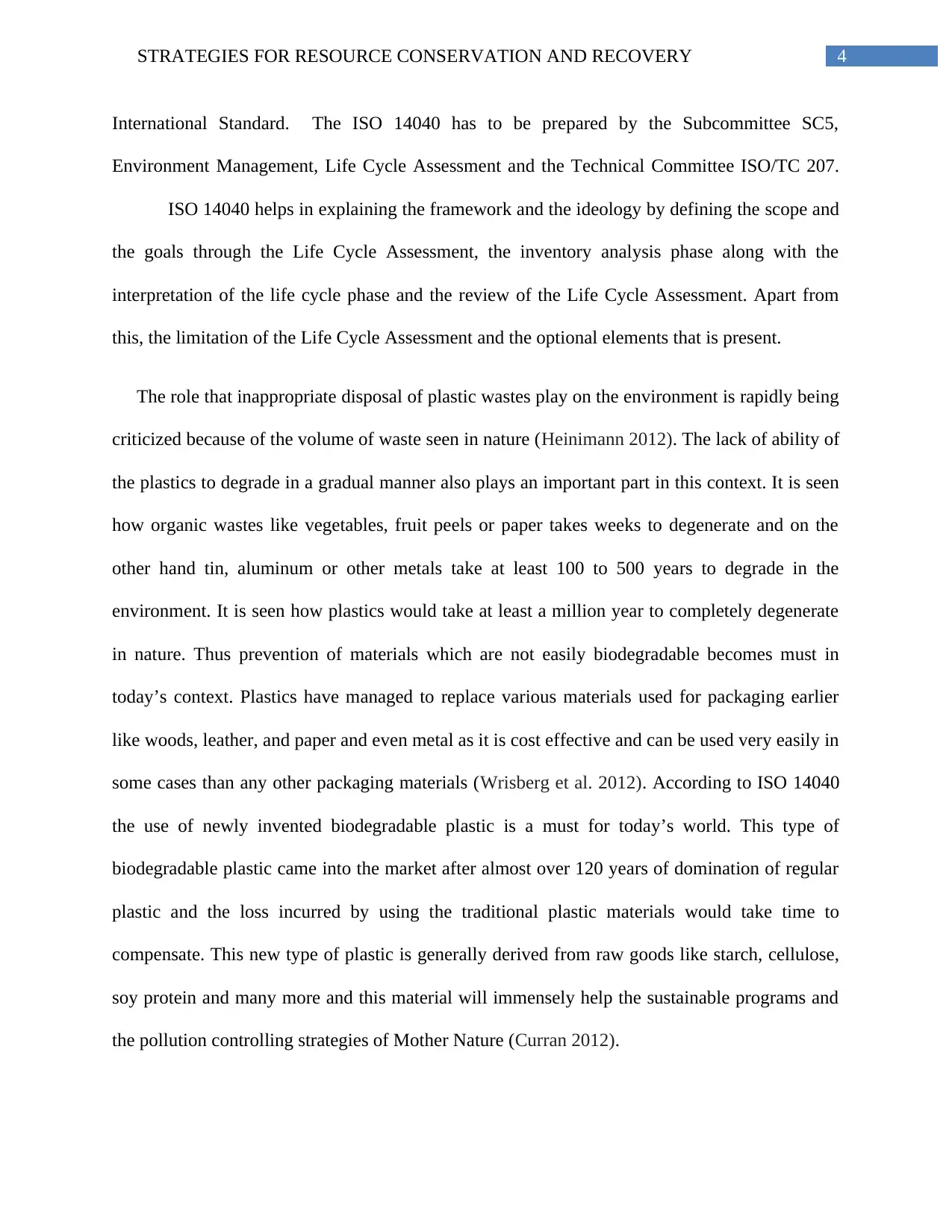
4STRATEGIES FOR RESOURCE CONSERVATION AND RECOVERY
International Standard. The ISO 14040 has to be prepared by the Subcommittee SC5,
Environment Management, Life Cycle Assessment and the Technical Committee ISO/TC 207.
ISO 14040 helps in explaining the framework and the ideology by defining the scope and
the goals through the Life Cycle Assessment, the inventory analysis phase along with the
interpretation of the life cycle phase and the review of the Life Cycle Assessment. Apart from
this, the limitation of the Life Cycle Assessment and the optional elements that is present.
The role that inappropriate disposal of plastic wastes play on the environment is rapidly being
criticized because of the volume of waste seen in nature (Heinimann 2012). The lack of ability of
the plastics to degrade in a gradual manner also plays an important part in this context. It is seen
how organic wastes like vegetables, fruit peels or paper takes weeks to degenerate and on the
other hand tin, aluminum or other metals take at least 100 to 500 years to degrade in the
environment. It is seen how plastics would take at least a million year to completely degenerate
in nature. Thus prevention of materials which are not easily biodegradable becomes must in
today’s context. Plastics have managed to replace various materials used for packaging earlier
like woods, leather, and paper and even metal as it is cost effective and can be used very easily in
some cases than any other packaging materials (Wrisberg et al. 2012). According to ISO 14040
the use of newly invented biodegradable plastic is a must for today’s world. This type of
biodegradable plastic came into the market after almost over 120 years of domination of regular
plastic and the loss incurred by using the traditional plastic materials would take time to
compensate. This new type of plastic is generally derived from raw goods like starch, cellulose,
soy protein and many more and this material will immensely help the sustainable programs and
the pollution controlling strategies of Mother Nature (Curran 2012).
International Standard. The ISO 14040 has to be prepared by the Subcommittee SC5,
Environment Management, Life Cycle Assessment and the Technical Committee ISO/TC 207.
ISO 14040 helps in explaining the framework and the ideology by defining the scope and
the goals through the Life Cycle Assessment, the inventory analysis phase along with the
interpretation of the life cycle phase and the review of the Life Cycle Assessment. Apart from
this, the limitation of the Life Cycle Assessment and the optional elements that is present.
The role that inappropriate disposal of plastic wastes play on the environment is rapidly being
criticized because of the volume of waste seen in nature (Heinimann 2012). The lack of ability of
the plastics to degrade in a gradual manner also plays an important part in this context. It is seen
how organic wastes like vegetables, fruit peels or paper takes weeks to degenerate and on the
other hand tin, aluminum or other metals take at least 100 to 500 years to degrade in the
environment. It is seen how plastics would take at least a million year to completely degenerate
in nature. Thus prevention of materials which are not easily biodegradable becomes must in
today’s context. Plastics have managed to replace various materials used for packaging earlier
like woods, leather, and paper and even metal as it is cost effective and can be used very easily in
some cases than any other packaging materials (Wrisberg et al. 2012). According to ISO 14040
the use of newly invented biodegradable plastic is a must for today’s world. This type of
biodegradable plastic came into the market after almost over 120 years of domination of regular
plastic and the loss incurred by using the traditional plastic materials would take time to
compensate. This new type of plastic is generally derived from raw goods like starch, cellulose,
soy protein and many more and this material will immensely help the sustainable programs and
the pollution controlling strategies of Mother Nature (Curran 2012).
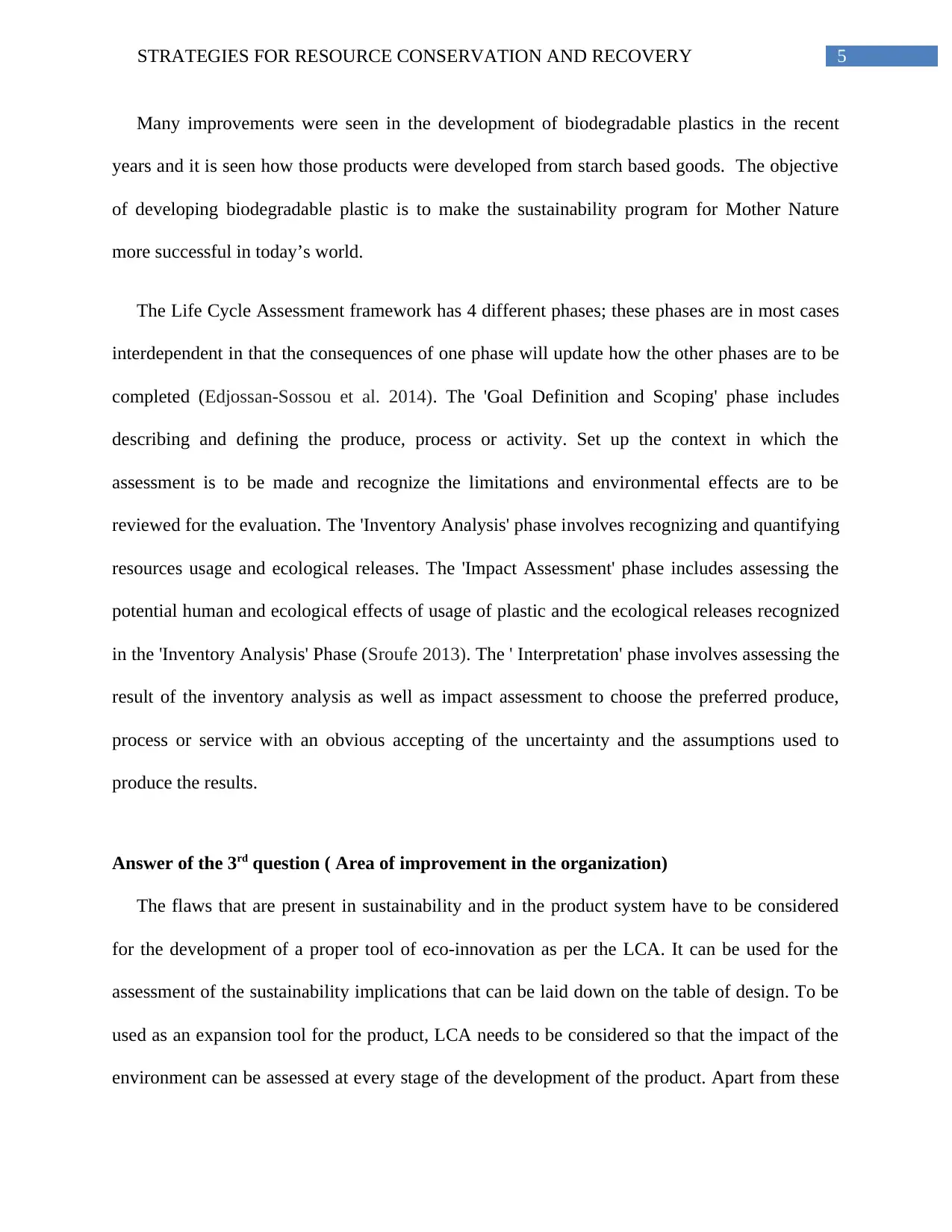
5STRATEGIES FOR RESOURCE CONSERVATION AND RECOVERY
Many improvements were seen in the development of biodegradable plastics in the recent
years and it is seen how those products were developed from starch based goods. The objective
of developing biodegradable plastic is to make the sustainability program for Mother Nature
more successful in today’s world.
The Life Cycle Assessment framework has 4 different phases; these phases are in most cases
interdependent in that the consequences of one phase will update how the other phases are to be
completed (Edjossan-Sossou et al. 2014). The 'Goal Definition and Scoping' phase includes
describing and defining the produce, process or activity. Set up the context in which the
assessment is to be made and recognize the limitations and environmental effects are to be
reviewed for the evaluation. The 'Inventory Analysis' phase involves recognizing and quantifying
resources usage and ecological releases. The 'Impact Assessment' phase includes assessing the
potential human and ecological effects of usage of plastic and the ecological releases recognized
in the 'Inventory Analysis' Phase (Sroufe 2013). The ' Interpretation' phase involves assessing the
result of the inventory analysis as well as impact assessment to choose the preferred produce,
process or service with an obvious accepting of the uncertainty and the assumptions used to
produce the results.
Answer of the 3rd question ( Area of improvement in the organization)
The flaws that are present in sustainability and in the product system have to be considered
for the development of a proper tool of eco-innovation as per the LCA. It can be used for the
assessment of the sustainability implications that can be laid down on the table of design. To be
used as an expansion tool for the product, LCA needs to be considered so that the impact of the
environment can be assessed at every stage of the development of the product. Apart from these
Many improvements were seen in the development of biodegradable plastics in the recent
years and it is seen how those products were developed from starch based goods. The objective
of developing biodegradable plastic is to make the sustainability program for Mother Nature
more successful in today’s world.
The Life Cycle Assessment framework has 4 different phases; these phases are in most cases
interdependent in that the consequences of one phase will update how the other phases are to be
completed (Edjossan-Sossou et al. 2014). The 'Goal Definition and Scoping' phase includes
describing and defining the produce, process or activity. Set up the context in which the
assessment is to be made and recognize the limitations and environmental effects are to be
reviewed for the evaluation. The 'Inventory Analysis' phase involves recognizing and quantifying
resources usage and ecological releases. The 'Impact Assessment' phase includes assessing the
potential human and ecological effects of usage of plastic and the ecological releases recognized
in the 'Inventory Analysis' Phase (Sroufe 2013). The ' Interpretation' phase involves assessing the
result of the inventory analysis as well as impact assessment to choose the preferred produce,
process or service with an obvious accepting of the uncertainty and the assumptions used to
produce the results.
Answer of the 3rd question ( Area of improvement in the organization)
The flaws that are present in sustainability and in the product system have to be considered
for the development of a proper tool of eco-innovation as per the LCA. It can be used for the
assessment of the sustainability implications that can be laid down on the table of design. To be
used as an expansion tool for the product, LCA needs to be considered so that the impact of the
environment can be assessed at every stage of the development of the product. Apart from these
⊘ This is a preview!⊘
Do you want full access?
Subscribe today to unlock all pages.

Trusted by 1+ million students worldwide
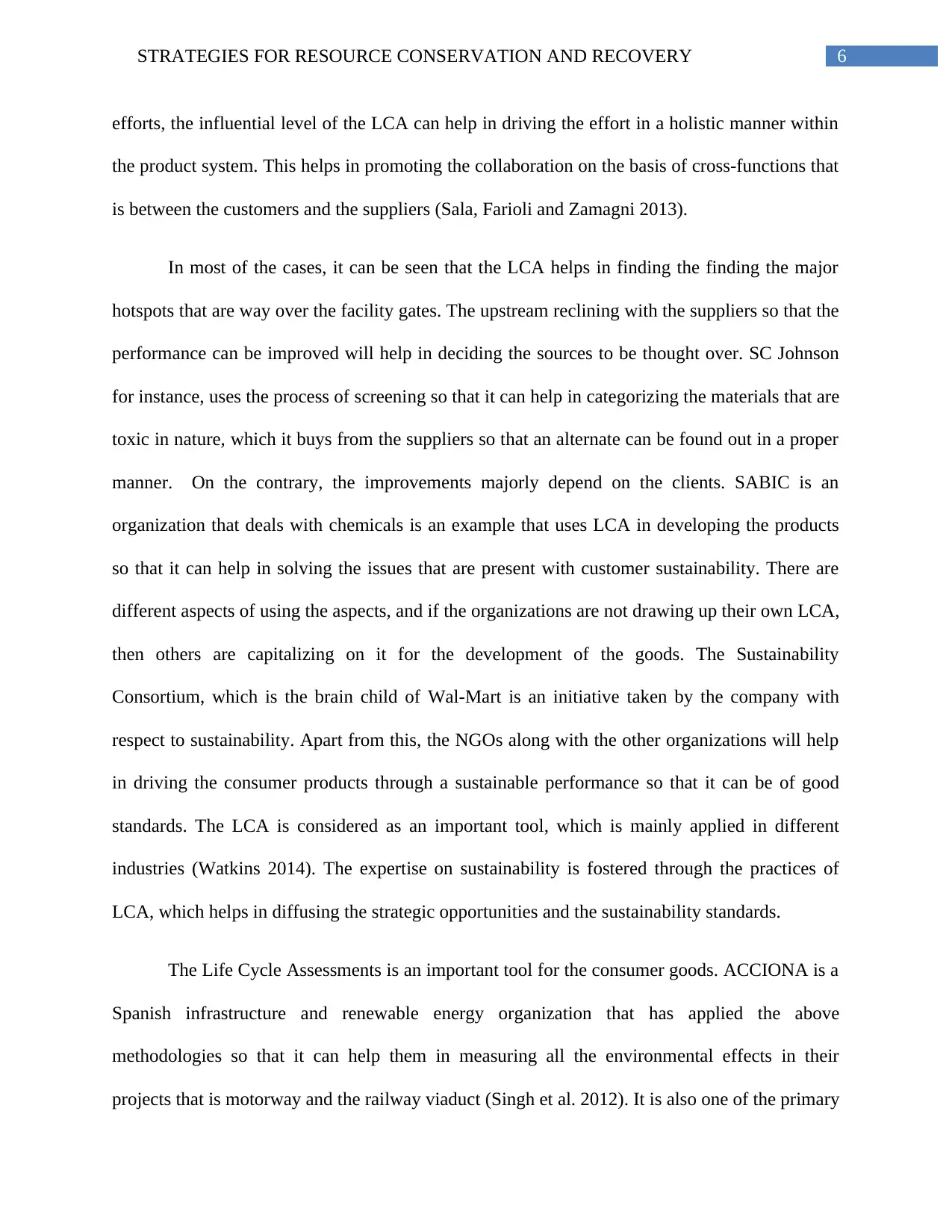
6STRATEGIES FOR RESOURCE CONSERVATION AND RECOVERY
efforts, the influential level of the LCA can help in driving the effort in a holistic manner within
the product system. This helps in promoting the collaboration on the basis of cross-functions that
is between the customers and the suppliers (Sala, Farioli and Zamagni 2013).
In most of the cases, it can be seen that the LCA helps in finding the finding the major
hotspots that are way over the facility gates. The upstream reclining with the suppliers so that the
performance can be improved will help in deciding the sources to be thought over. SC Johnson
for instance, uses the process of screening so that it can help in categorizing the materials that are
toxic in nature, which it buys from the suppliers so that an alternate can be found out in a proper
manner. On the contrary, the improvements majorly depend on the clients. SABIC is an
organization that deals with chemicals is an example that uses LCA in developing the products
so that it can help in solving the issues that are present with customer sustainability. There are
different aspects of using the aspects, and if the organizations are not drawing up their own LCA,
then others are capitalizing on it for the development of the goods. The Sustainability
Consortium, which is the brain child of Wal-Mart is an initiative taken by the company with
respect to sustainability. Apart from this, the NGOs along with the other organizations will help
in driving the consumer products through a sustainable performance so that it can be of good
standards. The LCA is considered as an important tool, which is mainly applied in different
industries (Watkins 2014). The expertise on sustainability is fostered through the practices of
LCA, which helps in diffusing the strategic opportunities and the sustainability standards.
The Life Cycle Assessments is an important tool for the consumer goods. ACCIONA is a
Spanish infrastructure and renewable energy organization that has applied the above
methodologies so that it can help them in measuring all the environmental effects in their
projects that is motorway and the railway viaduct (Singh et al. 2012). It is also one of the primary
efforts, the influential level of the LCA can help in driving the effort in a holistic manner within
the product system. This helps in promoting the collaboration on the basis of cross-functions that
is between the customers and the suppliers (Sala, Farioli and Zamagni 2013).
In most of the cases, it can be seen that the LCA helps in finding the finding the major
hotspots that are way over the facility gates. The upstream reclining with the suppliers so that the
performance can be improved will help in deciding the sources to be thought over. SC Johnson
for instance, uses the process of screening so that it can help in categorizing the materials that are
toxic in nature, which it buys from the suppliers so that an alternate can be found out in a proper
manner. On the contrary, the improvements majorly depend on the clients. SABIC is an
organization that deals with chemicals is an example that uses LCA in developing the products
so that it can help in solving the issues that are present with customer sustainability. There are
different aspects of using the aspects, and if the organizations are not drawing up their own LCA,
then others are capitalizing on it for the development of the goods. The Sustainability
Consortium, which is the brain child of Wal-Mart is an initiative taken by the company with
respect to sustainability. Apart from this, the NGOs along with the other organizations will help
in driving the consumer products through a sustainable performance so that it can be of good
standards. The LCA is considered as an important tool, which is mainly applied in different
industries (Watkins 2014). The expertise on sustainability is fostered through the practices of
LCA, which helps in diffusing the strategic opportunities and the sustainability standards.
The Life Cycle Assessments is an important tool for the consumer goods. ACCIONA is a
Spanish infrastructure and renewable energy organization that has applied the above
methodologies so that it can help them in measuring all the environmental effects in their
projects that is motorway and the railway viaduct (Singh et al. 2012). It is also one of the primary
Paraphrase This Document
Need a fresh take? Get an instant paraphrase of this document with our AI Paraphraser
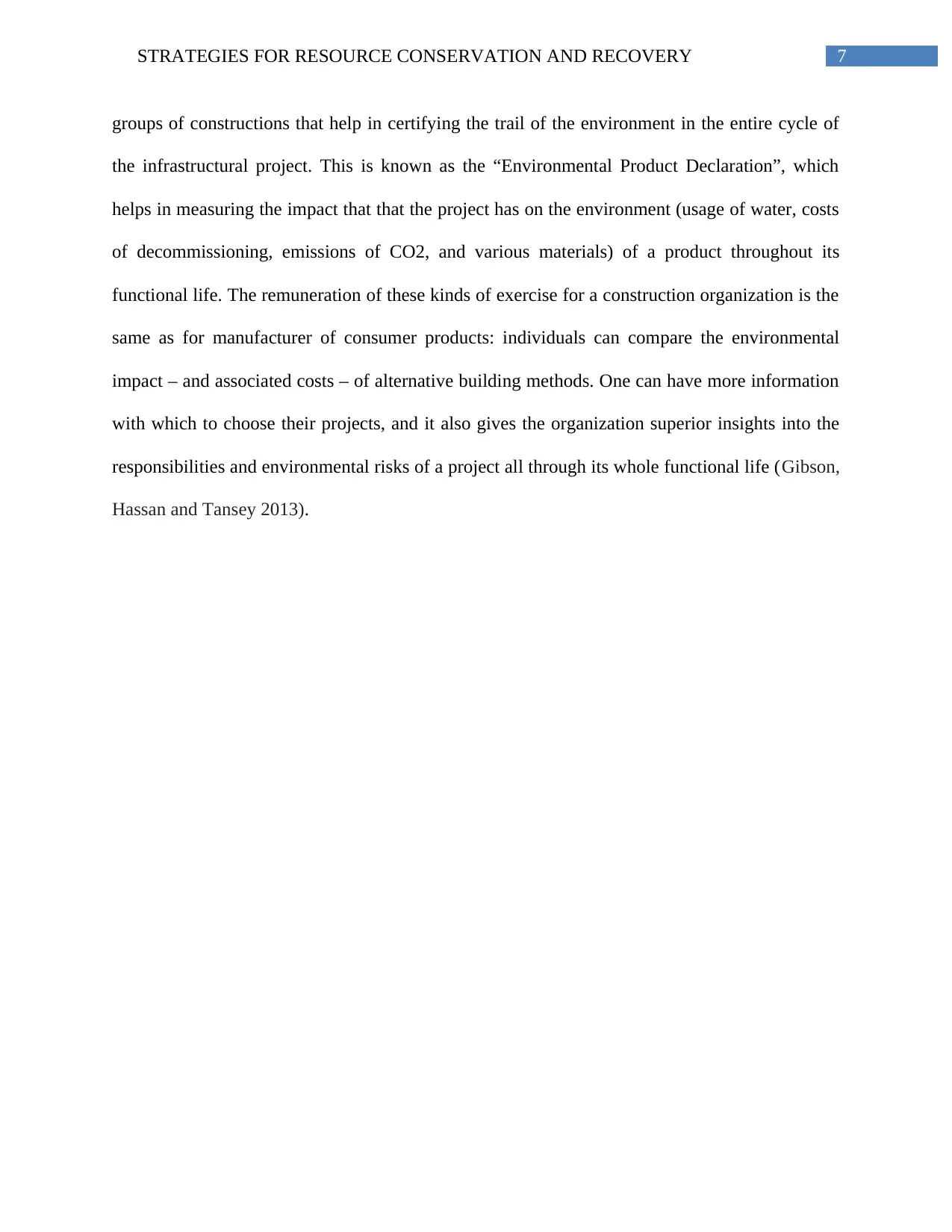
7STRATEGIES FOR RESOURCE CONSERVATION AND RECOVERY
groups of constructions that help in certifying the trail of the environment in the entire cycle of
the infrastructural project. This is known as the “Environmental Product Declaration”, which
helps in measuring the impact that that the project has on the environment (usage of water, costs
of decommissioning, emissions of CO2, and various materials) of a product throughout its
functional life. The remuneration of these kinds of exercise for a construction organization is the
same as for manufacturer of consumer products: individuals can compare the environmental
impact – and associated costs – of alternative building methods. One can have more information
with which to choose their projects, and it also gives the organization superior insights into the
responsibilities and environmental risks of a project all through its whole functional life (Gibson,
Hassan and Tansey 2013).
groups of constructions that help in certifying the trail of the environment in the entire cycle of
the infrastructural project. This is known as the “Environmental Product Declaration”, which
helps in measuring the impact that that the project has on the environment (usage of water, costs
of decommissioning, emissions of CO2, and various materials) of a product throughout its
functional life. The remuneration of these kinds of exercise for a construction organization is the
same as for manufacturer of consumer products: individuals can compare the environmental
impact – and associated costs – of alternative building methods. One can have more information
with which to choose their projects, and it also gives the organization superior insights into the
responsibilities and environmental risks of a project all through its whole functional life (Gibson,
Hassan and Tansey 2013).
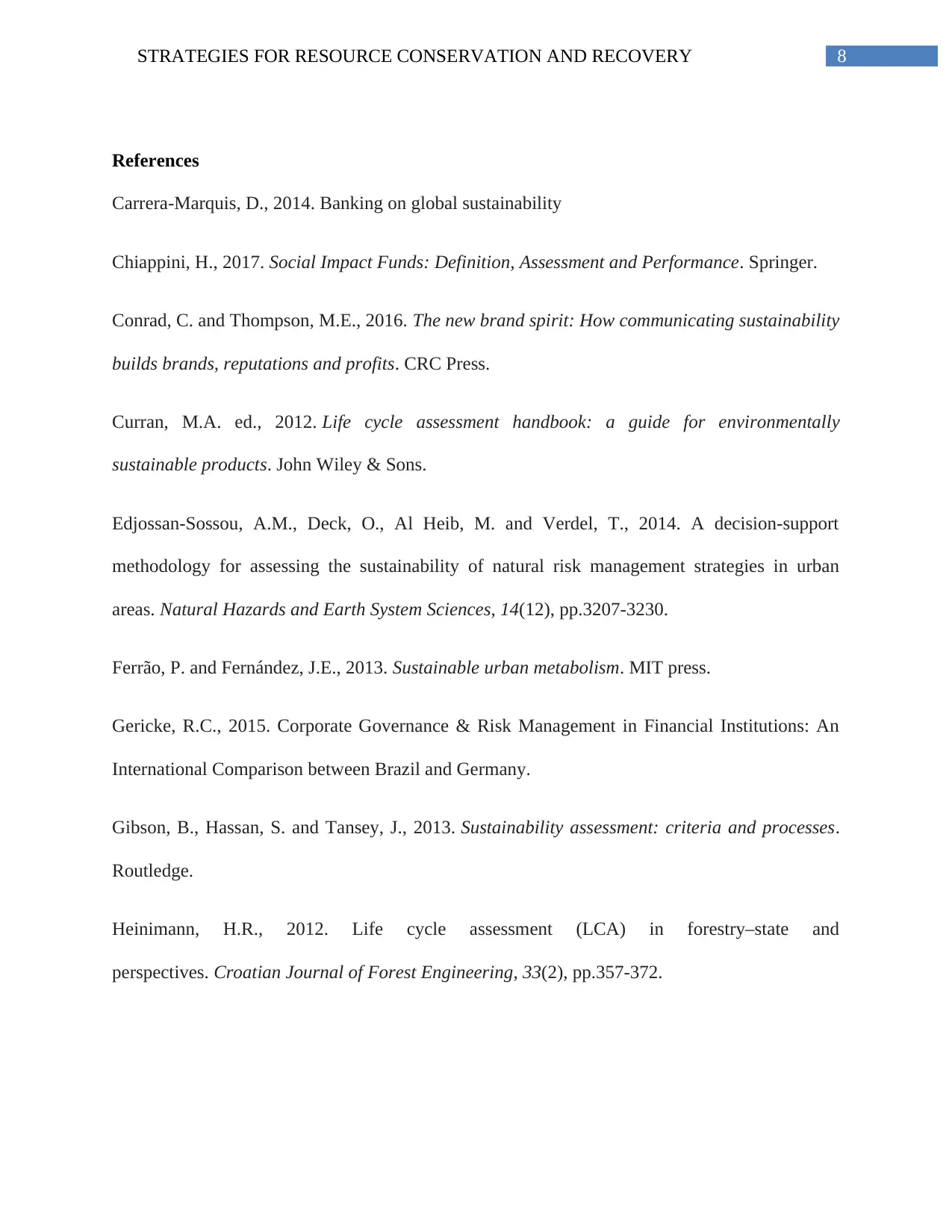
8STRATEGIES FOR RESOURCE CONSERVATION AND RECOVERY
References
Carrera-Marquis, D., 2014. Banking on global sustainability
Chiappini, H., 2017. Social Impact Funds: Definition, Assessment and Performance. Springer.
Conrad, C. and Thompson, M.E., 2016. The new brand spirit: How communicating sustainability
builds brands, reputations and profits. CRC Press.
Curran, M.A. ed., 2012. Life cycle assessment handbook: a guide for environmentally
sustainable products. John Wiley & Sons.
Edjossan-Sossou, A.M., Deck, O., Al Heib, M. and Verdel, T., 2014. A decision-support
methodology for assessing the sustainability of natural risk management strategies in urban
areas. Natural Hazards and Earth System Sciences, 14(12), pp.3207-3230.
Ferrão, P. and Fernández, J.E., 2013. Sustainable urban metabolism. MIT press.
Gericke, R.C., 2015. Corporate Governance & Risk Management in Financial Institutions: An
International Comparison between Brazil and Germany.
Gibson, B., Hassan, S. and Tansey, J., 2013. Sustainability assessment: criteria and processes.
Routledge.
Heinimann, H.R., 2012. Life cycle assessment (LCA) in forestry–state and
perspectives. Croatian Journal of Forest Engineering, 33(2), pp.357-372.
References
Carrera-Marquis, D., 2014. Banking on global sustainability
Chiappini, H., 2017. Social Impact Funds: Definition, Assessment and Performance. Springer.
Conrad, C. and Thompson, M.E., 2016. The new brand spirit: How communicating sustainability
builds brands, reputations and profits. CRC Press.
Curran, M.A. ed., 2012. Life cycle assessment handbook: a guide for environmentally
sustainable products. John Wiley & Sons.
Edjossan-Sossou, A.M., Deck, O., Al Heib, M. and Verdel, T., 2014. A decision-support
methodology for assessing the sustainability of natural risk management strategies in urban
areas. Natural Hazards and Earth System Sciences, 14(12), pp.3207-3230.
Ferrão, P. and Fernández, J.E., 2013. Sustainable urban metabolism. MIT press.
Gericke, R.C., 2015. Corporate Governance & Risk Management in Financial Institutions: An
International Comparison between Brazil and Germany.
Gibson, B., Hassan, S. and Tansey, J., 2013. Sustainability assessment: criteria and processes.
Routledge.
Heinimann, H.R., 2012. Life cycle assessment (LCA) in forestry–state and
perspectives. Croatian Journal of Forest Engineering, 33(2), pp.357-372.
⊘ This is a preview!⊘
Do you want full access?
Subscribe today to unlock all pages.

Trusted by 1+ million students worldwide
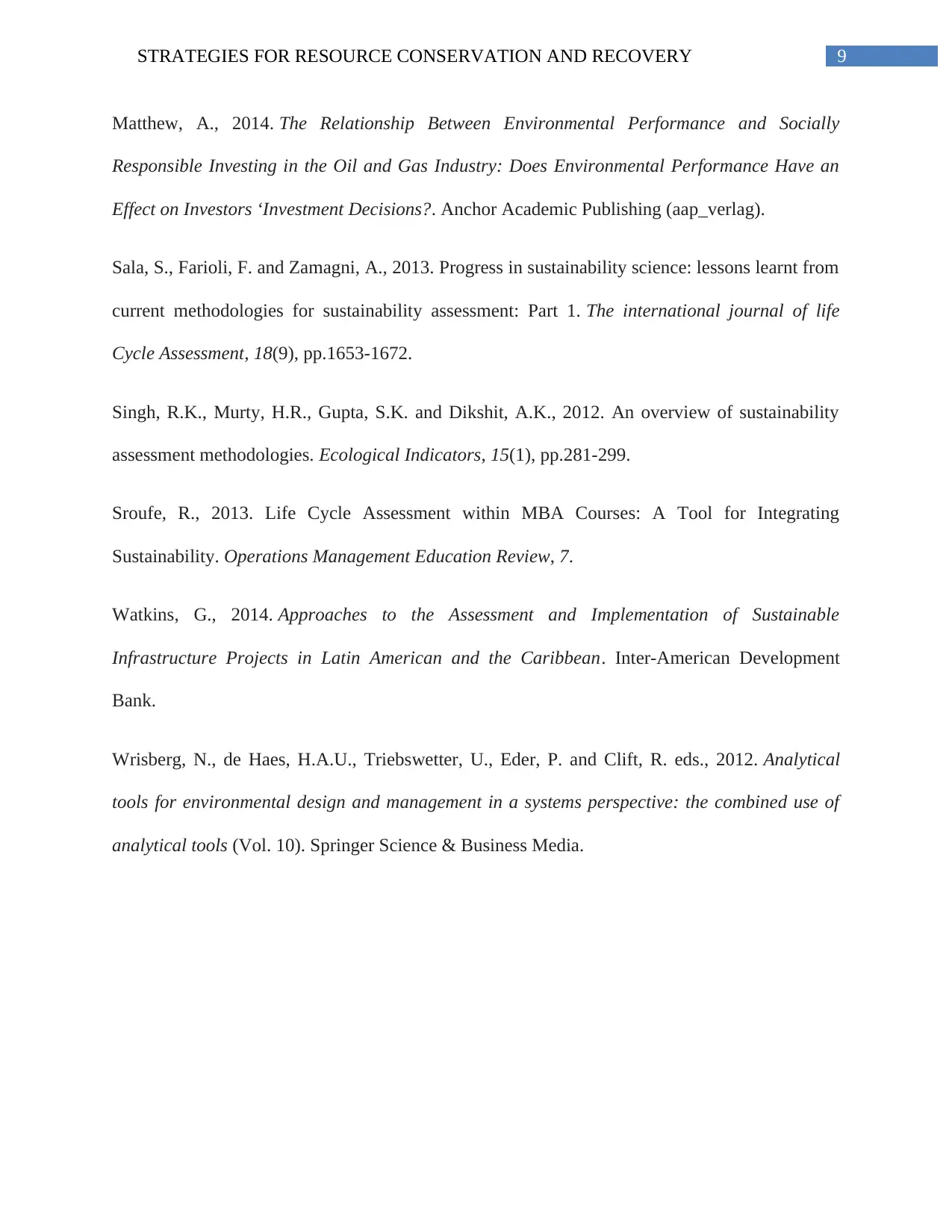
9STRATEGIES FOR RESOURCE CONSERVATION AND RECOVERY
Matthew, A., 2014. The Relationship Between Environmental Performance and Socially
Responsible Investing in the Oil and Gas Industry: Does Environmental Performance Have an
Effect on Investors ‘Investment Decisions?. Anchor Academic Publishing (aap_verlag).
Sala, S., Farioli, F. and Zamagni, A., 2013. Progress in sustainability science: lessons learnt from
current methodologies for sustainability assessment: Part 1. The international journal of life
Cycle Assessment, 18(9), pp.1653-1672.
Singh, R.K., Murty, H.R., Gupta, S.K. and Dikshit, A.K., 2012. An overview of sustainability
assessment methodologies. Ecological Indicators, 15(1), pp.281-299.
Sroufe, R., 2013. Life Cycle Assessment within MBA Courses: A Tool for Integrating
Sustainability. Operations Management Education Review, 7.
Watkins, G., 2014. Approaches to the Assessment and Implementation of Sustainable
Infrastructure Projects in Latin American and the Caribbean. Inter-American Development
Bank.
Wrisberg, N., de Haes, H.A.U., Triebswetter, U., Eder, P. and Clift, R. eds., 2012. Analytical
tools for environmental design and management in a systems perspective: the combined use of
analytical tools (Vol. 10). Springer Science & Business Media.
Matthew, A., 2014. The Relationship Between Environmental Performance and Socially
Responsible Investing in the Oil and Gas Industry: Does Environmental Performance Have an
Effect on Investors ‘Investment Decisions?. Anchor Academic Publishing (aap_verlag).
Sala, S., Farioli, F. and Zamagni, A., 2013. Progress in sustainability science: lessons learnt from
current methodologies for sustainability assessment: Part 1. The international journal of life
Cycle Assessment, 18(9), pp.1653-1672.
Singh, R.K., Murty, H.R., Gupta, S.K. and Dikshit, A.K., 2012. An overview of sustainability
assessment methodologies. Ecological Indicators, 15(1), pp.281-299.
Sroufe, R., 2013. Life Cycle Assessment within MBA Courses: A Tool for Integrating
Sustainability. Operations Management Education Review, 7.
Watkins, G., 2014. Approaches to the Assessment and Implementation of Sustainable
Infrastructure Projects in Latin American and the Caribbean. Inter-American Development
Bank.
Wrisberg, N., de Haes, H.A.U., Triebswetter, U., Eder, P. and Clift, R. eds., 2012. Analytical
tools for environmental design and management in a systems perspective: the combined use of
analytical tools (Vol. 10). Springer Science & Business Media.
1 out of 10
Related Documents
Your All-in-One AI-Powered Toolkit for Academic Success.
+13062052269
info@desklib.com
Available 24*7 on WhatsApp / Email
![[object Object]](/_next/static/media/star-bottom.7253800d.svg)
Unlock your academic potential
Copyright © 2020–2025 A2Z Services. All Rights Reserved. Developed and managed by ZUCOL.




